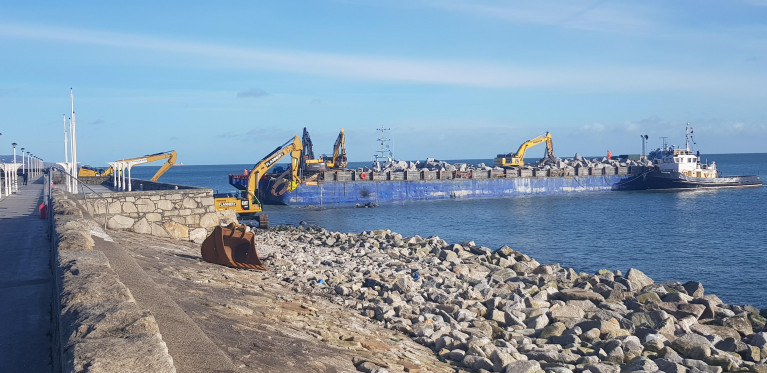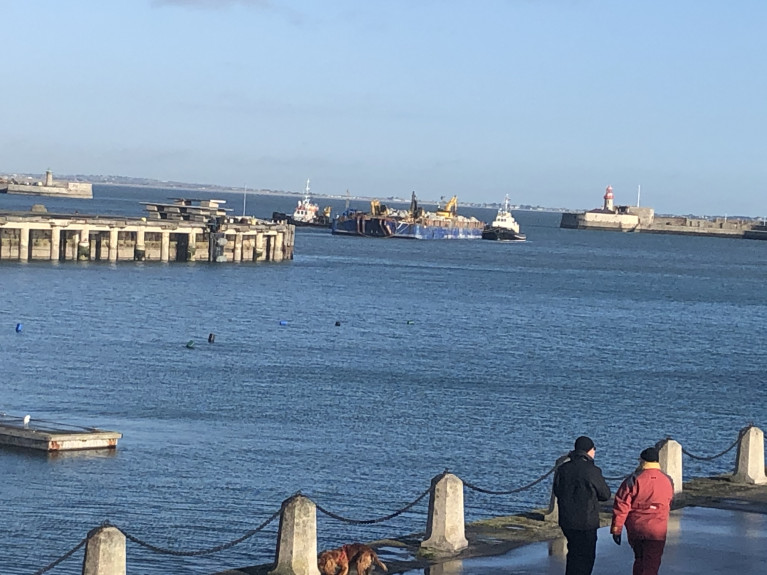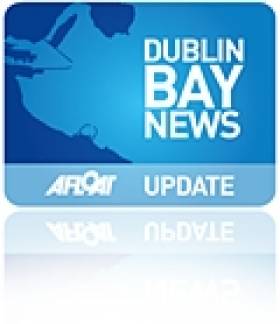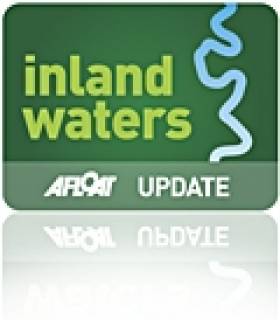Displaying items by tag: Repairs
Fishguard Ferry Off-Service Undergoes Repairs on Merseyside Shipyard
The Rosslare-Fishguard Stena Line ferry, which following an engine-room blaze that occurred over a week ago, is in for repairs at a shipyard on Merseyside, writes Jehan Ashmore.
Stena Europe is berthed in the Tranmere basin at the Cammell Laird shipyard in Birkenhead (which is nearby to the ferry terminal/see story).
As Afloat previously reported the crew were able to extinguish the fire which took place as the ferry was nearing the Port of Fishguard in Pemrokeshire.
All passengers and crew were unharmed having arrived to the Welsh port and from where rescue authorities were on hand to also assist as a precaution.
An investigation as to the cause of the fire is underway on the 1981 built ship which is the oldest ferry on the Irish Sea and of the Stena fleet. The Swedish owned company has a route network also on the North Sea and throughout Scandinavia.
While Stena Europe is away from the St. George's Channel route, scheduled maintenance works will also take place in Birkenhead on the ferry which arrived on Merseyside last Tuesday. This following an overnight passage from Fishguard.
According to the Stena website, sailings on the Rosslare-Fishguard route up until 26th February are suspended and all traffic (including foot passengers) will be accommodated on an alternative sailing.
This involves customers transferring to rival operator Irish Ferries on the Rosslare-Pembroke Dock route served by the chartered in Blue Star 1.
In addition Stena have facilitated those travelling with another alternative by travelling instead on their Dublin-Holyhead route.
Work to Repair Main Isle of Man Ferry to Cause Disruption in March
Work to repair the Isle of Man Steam Packet Company’s main passenger ferry operating the Douglas-Heysham route will see overnight sailings from Lancashire temporarily scrapped next month.
The Steam Packet’s ropax, Ben-my-Chree is to head to the Mersey and enter dry-dock from 23 to 31 March at the Cammell Laird shipyard in Birkenhead.
According to the ferry firm, work had been brought forward to ensure a "resilient service" ahead of the arrival of the new ferry the Manxman which has been delayed due to a gearbox fault.
While the Ben-My-Chree is off service, the fast-craft ferry, Manannan will operate daytime passenger services on the Douglas-Heysham during the period.
The operator’s relief freight-ferry, MV Arrow will carry out evening services.
As for passengers affected by the disruption, they will be contacted in the coming days, a Steam Packet spokesman said.
Further coverage from the BBC News on the impact to schedules.
Sailing Disruption As Isle of Man Ferry is to Require Repairs
Sailings to and from the Isle of Man will be disrupted at the end of the month as the ferry Ben-my-Chree undergoes repairs.
The ferry operator, the Isle of Man Steam Packet Company said the (fastferry) Manannan would undertake daytime crossings between Douglas and Heysham from 30 October.
Due to the "scope and complexity" of the work needed, the Ben-my-Chree would be at Cammell Laird's (shipyard) facility for six days, the firm added.
Overnight freight sailings would be carried out by MV Arrow.
The vessel, which had been held on a long-term lease, was recently bought by the ferry firm as Afloat previously reported on the 84 trailer unit capacity freighter.
As a result of the changes, usual evening passenger sailings from the island to Lancashire, and the overnight return will not take place.
More from BBC News including an apology from the ferry operator due to the disruption.
Repairs in Douglas Harbour Needed to Protect Newbuild Ferry from Storms
Douglas Harbour is to undergo major works that are needed to protect the new Isle of Man Steam Packet ferry, the infrastructure minister has said.
Chris Thomas said the project would reduce the risk of damage to the Manxman and the harbour in high winds.
The plans would see repairs to the walls of King Edward VIII Pier and fenders and mooring bollards replaced.
The proposed works are scheduled to start in later summer next year and be completed ahead of the winter.
Construction works, which would take place around scheduled ferry sailings, would make sure the new larger vessel was "well-protected heading into the winter months", Mr Thomas said.
Under construction in South Korea, the Manxman will be 26ft (8m) longer than Ben-my-Chree and is due to come into service in spring.
More details writes BBC News on the new installations required to berth the newbuild.
The famine replica tallship Dunbrody is taking longer to repair than expected, meaning it will be at least late July before it is back moored outside the visitor centre, according to the New Ross Standard.
It was early March when the vessel was tugged across the Barrow to New Ross Boat Yard to go into dry dock, set to return in late May or early June.
Dunbrody Experience Visitor Centre CEO Sean Connick said works have gone a little slower than expected. 'It will be late July but she will look fabulous.'
Serious structural issues in the vessel were exposed in November when its foremast snapped in two in November, prompting a section of the boardwalk to be sealed off. This highlighted the urgent need for repairs for the 176ft, 20-year-old vessel, which attracts around 65,000 visits annually.
€700,000 was set aside for the repair works.
For more click here.
Barge Departs But Works to Shore-Up Storm Damage Continue at E. Pier, Dun Laoghaire Harbour
Works to repair damage at the East Pier, Dun Laoghaire Harbour in Dublin Bay, that began last year on coastal defences should be completed in the coming weeks, writes Jehan Ashmore.
According to Dun Laoghaire-Rathdown County Council the works to replenish rock-armour from the damage caused by Storm Emma in 2018 should be completed by the end of March.
As Afloat previously reported a barge laden with 1,700 tonnes of Cornish granite boulders are being used to repair the outside of the East Pier.
Such work to position the rocks where required to shore-up coastal defences, is clearly evident when seen from the shores of Scotsman Bay as the new rocks are grey in colour compared to the surrounding slopes along the East Pier.
It is almost a fortnight since the barge towed by tug, Vanguard, departed Dun Laoghaire Harbour and back to the UK. DLRCoCo also confirmed to Afloat that this was the only shipment used in the project where contractors hired by the council are using heavy machinery.
The machinery involving digger/grabbers had to be tranported by sea (landing craft, James) from within the harbour to the outside of the East Pier due to accessiblility reasons.
Storms Past and Present Influence Repair Works in Dun Laoghaire Harbour
Works have recently begun to repair damage in Dun Laoghaire Harbour caused by a storm from almost two years ago, however further bad weather looms as Storm Dennis is to sweep in this weekend, writes Jehan Ashmore.
As Afloat reported in November, a landing-craft vessel in the harbour assisted a contractor which Dun Laoghaire-Rathdown County Council tasked to repair damage notably at the East Pier following Storm Emma in March 2018. Due to access issues, diggers were transported by sea to land ashore on both the seaward sides of the West and East Piers.
Ironically Storm Ciara made its presence felt in regards to repair works required at the East Pier. As Afloat also reported, a section of the pier's revetments removed by Storm Emma were due to receive replenished rock armour. This work was expected to be completed by Christmas, however, it was only last week that a tug towing a barge laden with 1,700 tonnes of Cornish granite arrived at the harbour.
As the weather abated, the tug Vanguard which made the delivery voyage, was joined in the harbour on Wednesday by Wicklow based tug, AMS Retriever to assist in the short-distance towing operation. The tugs departed St. Michael's Pier along with the barge that was positioned in Scotman's Bay in close proximity off the East Pier.
 The Vanguard with accompanying tugs offloads its rock cargo at the back of Dun Laoghaire's East Pier Photo: Afloat
The Vanguard with accompanying tugs offloads its rock cargo at the back of Dun Laoghaire's East Pier Photo: Afloat
According to DLRCoCo, the works at the East Pier are scheduled to be completed by the end of February.
On a related note to the weather in the harbour, Storm Ciara led to three Belgium registered trawlers forced to take refuge by sheltering within the harbour.
The trio of beam-trawlers berthed alongside Carlisle Pier involved Avatar (Z-333) and rafted alongside Francine (Z 90). While the third trawler, De Marie Louise (Z 47) berthed ahead but nearer to the pierhead.
As weather conditions improved, the trawlers departed back into the Irish Sea.
#DunLaoghaire - A section of Dun Laoghaire's East Pier is at risk of structural failure and requires repairs at a cost of up to €5 million, according to an unpublished engineer's report obtained by RTÉ News.
Afloat.ie previously reported on the existence of the report, commissioned by the Dun Laoghaire Harbour Company, which it's been claimed highlights a number of issues across the south Dublin harbour's three main piers.
The biggest of these concerns a 75-metre section of the East Pier where the recently approved 'urban beach' project will be developed in time for the 2016 summer season.
Steel structural beams supporting Berth 1 on the pier are described as being "at risk of corrosion or failure".
The pier will not have to be closed while repairs are made, as the platform jutting out from the main pier into the harbour is still "completely safe", according to harbour master Simon Coate.
But the cost of repairs is expected to be anywhere between €1 million and €5 million.
RTÉ News has more on the story HERE.
#sailmaker – Veteran pro solo sailor Yannick Lemonnier has opened Quantum sail loft in Galway docks to service both the Southern and Northern Ireland sailing markets.
Lemonnier, a double handed Round Ireland record holder, says he will service and repair any type of sail; cruisers, racers, dinghies, windsurf, kitesurf and even windmill sails.
With an impressive floor area of nearly 450 sq.metres, the Galway harbour loft is capable of handling the largest sails such as for VOR70 or MOD70 racing yachts and operates collection points from Dublin and Cork.
The French sailmaker has an impressive sailing CV, having sailed in excess of 70,000 miles, mostly single handed or double-handed, and competed in five 'Solitaire du Figaro', 2 Transatlantic race double-handed "AG2R", won 2 French National Student match-racing, won French National Student cruiser/ racer title and has competed in many "Tour Voile", "Spi Ouest France", Cowes Week (TP52), Fasnet Races.
The international Quantum Sail Design Group was formed in 1996 by a group of independent and experienced sailmakers. The firm has grown to more than 60 sales and service outlets throughout the world with headquarters in Traverse City, Michigan, USA. Sails are built at three, state-of-the-art manufacturing centers strategically located around the globe.
More on the new Galway loft here
Lock One Repairs Complete On Shannon-Erne Waterway
#InlandWaterways - Waterways Ireland advises masters and owners of vessels that repairs to the lock and gates at Lock 1 Corraquill on the Shannon-Erne Waterway in Co Fermanagh which began on 29 January have now been completed.


































































